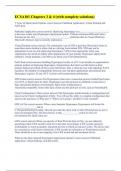Copyright © KAYLIN 2024/2025 ACADEMIC YEAR. ALL RIGHTS RESERVED FIRST PUBLISH NOVEMBER, 2024
UBCO BIOL 205 Invertebrate Zoology II
Exam Study Guide Solutions
Phylum Nemertea - ANSWER✔✔-Ribbon worms. ~1200 species, usually dioecious, protonephridia,
extensible proboscis (stored in rhynchocoel), pilidium larvae in some. Includes Class Palaeonemerata,
Class Pilidiophora (pilidium larvae), and Class Hoplonemerata (posess stylets)
Phylum Mollusca - ANSWER✔✔-Can have a shell secreted by mantle, head/foot houses feeding, sensory,
and locomotive structures, radula feeding structure, foot for locomotion, visceral mass contains major
organs, ctenidial gills, trochophore and/or veliger larvae. Includes Classes Caudofoveata, Solenogastres,
Monoplscophora, Scaphopoda, Polyplacophora, Bivalvia, Gastropoda, and Cephalopoda.
Mollusc Shell Layers - ANSWER✔✔-Nacreous layer is innermost, iridescent, aqueous, mostly calcium
carbonate. Prismatic layer is thickest layer, made of calcium carbonate, proteins, and chiton, secreted by
band of cells in mantle. Periostracum is outermost layer, proteinaceous, relatively thin, produced out at
margins
Mollusc larvae - ANSWER✔✔-Trochophore larva are planktonic, bands of cilia. Veliger larva are actively
swimming, unique to molluscs, have cilia on their velum.
Class Caudofoveata and Solenogastres - ANSWER✔✔-All marine, worm-like, no shell, no fossil evidence,
~300 species
Class Monoplacophora - ANSWER✔✔-Single shell, univalve, serially repetitious nephridia, ~30 species
Copyright ©Stuvia International BV 2010-2024 Page 1/6
, Copyright © KAYLIN 2024/2025 ACADEMIC YEAR. ALL RIGHTS RESERVED FIRST PUBLISH NOVEMBER, 2024
Class Scaphopoda - ANSWER✔✔-Tusk shells, use foot to burrow into sediment with smaller opening
exposed to pull in water, deposit feeders ~300 species
Class Polyplacophora - ANSWER✔✔-Includes chitons, shell has 8 valves/plates, repeating gills, move by
pedal waves, no eyes or style
Class Bivalvia - ANSWER✔✔-No head, no radula, mostly marine, two halves closed by adductor valves,
mantle forms siphons, ctenidial gills, suspension feeders, 3-chambered heart, open circulatory system,
dioecious, external fertilization, glochidium larvae, ~20 000 species. Includes Clams, Mussels, Scallops,
Ship worms, and Oysters
Class Gastropoda - ANSWER✔✔-Univalve, lost or reduced shell, do torsion, coiling, eat mostly by rasping,
open circulatory system, move along foot, ~40 000 species. Includes terrestrial and marine snails, slugs,
nudibranchs, and limpets
Torsion - ANSWER✔✔-Twisting of the visceral mass 180 degrees so the anus is near the head, results in
self-fouling, prevents buildup of sediment in gills. Detorsion is twisting 360 degrees
Coiling (of the Gastropod shell) - ANSWER✔✔-Allows for continuous growth. Can be Planospiral
(ancestral, bilateral symmetry) or Conispiral (Apex drawn out, better weight balance)
Subclass Pulmonata - ANSWER✔✔-terrestrial or freshwater snails and slugs, lung or gills, do detorsion
Subclass Prosobranchia - ANSWER✔✔-Marine snails and limpets, do torsion (gills in front)
Subclass Opisthobranchia - ANSWER✔✔-Sea slugs (nudibranchs) and sea hares, marine, no shell,
detorsion (gills in back), probably paraphyletic. Nudibranchs can store cnidocytes from the cnidaria they
consume
Copyright ©Stuvia International BV 2010-2024 Page 2/6





